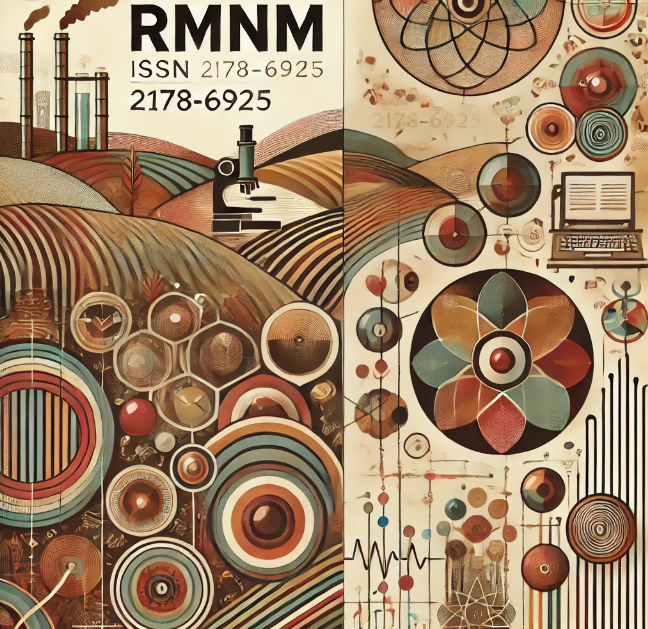EXCLUSION OF INDENTIFICATION OF FLOREST COVER IN PERMANENT PRESERVATION AREAS (APP)
DOI:
https://doi.org/10.61164/rmnm.v5i1.2403Keywords:
Compensation, Permanent preservation area, Forest CoverageAbstract
Introduction: Protected areas play a crucial role in preserving biodiversity and environmental conservation globally, with Natural Reserves and Permanent Preservation Areas (APPs) being fundamental for maintaining terrestrial and aquatic ecosystems. However, they face significant challenges in violating preservation measures, threatening both the environment and the quality of life of communities. Therefore, understanding this issue is essential in view of contemporary environmental and socioeconomic challenges. Objective: the objective of this study was to analyze the exclusion of vegetation cover in the compensation process for areas involved in APPs. Methodology: The methodology used in this study, based on a bibliographic survey in academic repositories and a qualitative data approach, provided a solid and comprehensive analysis of the exclusion of forest cover in expropriation processes, contributing to the construction of knowledge and the formulation of informed recommendations in scientific evidence. Results: The exclusion of vegetation cover during the expropriation process is an issue of great relevance, as it can have significant impacts on both the environment and society. By exploring this theme, the study sought to understand the legal and environmental foundations that govern the exclusion of vegetation cover in APP areas during the compensation process. The relevant legislation was examined, as well as jurisprudence and practical cases that address this issue, aiming to identify the main challenges and dilemmas faced by legislators, environmental agencies and land owners. Conclusion: Based on the analysis of the discussions and jurisprudence presented, it is concluded that the creation of preservation areas, such as the Serra do Mar State Park, does not automatically guarantee the right to compensation due to the restrictions already established by the Forest Code. Compensation is only due if the limitations of the state decree are stricter than those existing before the creation of the area and if there is economic loss.
References
ANTUNES, Paulo de Bessa. Áreas de preservação permanente urbanas. Revista de Informação Legislativa, Brasília, v. 52, n. 206, p. 83-102, 2015.
ARANTES, Leticia Tondato et al. Uma revisão sistemática sobre as abordagens e métodos utilizados no zoneamento ecológico-econômico no Brasil. Revista Principia-Divulgação Científica e Tecnológica do IFPB, 2022.
ARAUJO, Kesya Garcia Lacerda de. As construções irregulares em áreas de preservação permanente em zonas urbanas na cidade de Goiânia e o desrespeito ao meio ambiente equilibrado. 2021.
AUGUSTIN, Sérgio. A tutela penal ambiental e a evolução do meio ambiente como bem jurídico: um estudo de caso do tipo penal do artigo 38 da Lei nº 9.605/98. Revistas eletrônicas, v. 40 n. 2 (2014).
BENJAMIN, Antônio Herman. Desapropriação, reserva florestal legal e áreas de preservação permanente. In: FIGUEIREDO, Guilherme José Purvin (Coord.). Temas de direito ambiental e urbanístico. São Paulo: Max Limonad, 1998, p. 68
BORGES, Luís Antônio Coimbra et al. Áreas de preservação permanente na legislação ambiental brasileira. Ciência Rural, v. 41, p. 1202-1210, 2011.
BRANCALION, Pedro HS et al. Análise crítica da Lei de Proteção da Vegetação Nativa (2012), que substituiu o antigo Código Florestal: atualizações e ações em curso. Natureza & Conservação, v. 14, p. e1-e16, 2016.
BRASIL,. Lei nº 12.651, de 25 de maio de 2012. Dispõe sobre a proteção da vegetação nativa. Disponível em:< https://www.planalto.gov.br/ccivil_03/_ato2011-2014/2012/lei/l12651.htm> . Acesso em 10 abr.2024.
BRASIL. Lei nº 9.605, de 12 de fevereiro de 1998. Dispõe sobre as sanções penais e administrativas derivadas de condutas e atividades lesivas ao meio ambiente, e dá outras providências. Disponível em: https://www.planalto.gov.br/ccivil_03/leis/l9605.htm. Acesso em: 10 Abr. 2024.
CAMPOS JUNIOR, Raimundo Alves. O problema da indenização das áreas de preservação florestal (Análise doutrinária e jurisprudencial). Revista da Esmafe, v. 6, p. 139-188, 2004.
CARMO, Alexandre Batista; PIZELLA, Denise Gallo. A integração dos planos diretores municipais e planos de bacia hidrográfica: revisão do plano diretor do município de São José do Rio Preto (Sp).2022
CARVALHO FILHO, José dos Santos. Manual de direito administrativo. 25ª ed. São Paulo: Atlas, 2012.
CASTRO, Marina de et al. Os Institutos Da Reserva Legal E Área De Preservação Permanente Nas Propriedades Rurais: A Preservação Do Meio Ambiente Na Lei. 12.651/12. 2014.
CASTRO, Stéphanie Louise Inácio; MAY, Leda Ramos; GARCIAS, Carlos Mello. Meio Ambiente E Cidades-Áreas De Preservação Permanente (Apps) Marginais Urbanas Na Lei Federal N. 12.651/12. Ciência Florestal, v. 28, p. 1340-1349, 2018.
DELAGE FILHO, Luiz Audebert. O poder judiciário e o direito ambiental. 2013.
DIAS, Felipe Teixeira et al. Indicadores internacionais de produção científica interdisciplinar em áreas de preservação permanente brasileiras: uma revisão bibliométrica. Revista Gestão & Sustentabilidade Ambiental, v. 11, n. 1, p. 3-20, 2022.
FREITAS, Gilberto Passos; COELHO, Marcus Filipe Freitas. Indenização à proprietários de imóveis localizados em APPS. Revista Vertentes do Direito, v. 4, n. 1, p. 160-181, 2017.
LEVIN, Alexandre. Reserva legal como instrumento de política ambiental. https://enciclopediajuridica.pucsp.br/verbete/525/edicao-2/reserva-legal-como-instrumento-de-politica-ambiental
MARCON, Marco Antonio. Legislação ambiental aplicada às Áreas de Preservação Permanente (APP) no Litoral Norte do RS: estudo de caso das Lagoas Costeiras do Município de Cidreira. 2016.
SANTOS, Daniela Malschitzky dos et al. A Indenizabilidade das áreas de preservação permanente e reserva florestal legal instituídas em imóvel rural. 2009.
WITT, Patrícia Bernardes Rodrigues. Espaços territoriais especialmente protegidos:" biodiversidade e a gestão de áreas protegidas no Brasil". 2014.
Downloads
Published
How to Cite
Issue
Section
License
Copyright (c) 2024 Revista Multidisciplinar do Nordeste Mineiro

This work is licensed under a Creative Commons Attribution-NonCommercial-ShareAlike 4.0 International License.




